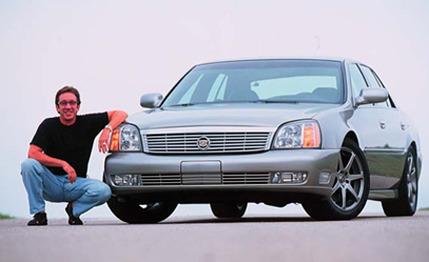 Specialty File
Specialty File
At Waterford Hills racetrack, it's easy to find comedian Tim Allen. Look for the ever-moving swarm: the TV cameras, the makeup men, the hangers-on, the "edgers," the guys pointing their disposable cameras. As Allen slips into the track's men's room, the swarm hovers expectantly at the entrance, awaiting a flush and a rustle of paper towels. The swarm is not embarrassed. The swarm is patient.
Wearing jeans, a black T-shirt, and purple-tinted sunglasses, this slim, surprisingly small man emerges from the pit-lane biffy. His forearms ripple with sinew and veins, as if he hoists weights.
Tim Allen faces the swarm, clicks his heels, and suddenly assumes a storm trooper's persona: "Vell, ze story ees zat I call ziss zilver-haired Chermin chentleman sigs monz ago, yah?" he announces. "'Herr Beitzel,' I zay to him, 'vee need ziss vast DeFille right avay, yah?'"
The swarm ruptures itself laughing.
"Herr Beitzel" is Jeffrey Beitzel, president of Wheel to Wheel, a prototype assembler in Troy, Michigan. Beitzel recently built six Seville STSi pace cars for Cadillac's Le Mans effort. Which means that building a hot-rod DeVille commissioned by TV celebrity Allen was a no-brainer. The hardware already existed. Well, it existed after Beitzel spent $120 grand.
"I looked at some other sedans [an Olds Aurora and a Lexus IS300] to modify," Allen says, "but I kept coming back to the DeVille. Every time I caught this thing from a rear three-quarter view, I said to myself [now affecting a Walter Brennan voice], Gotta have this, all two tons of it."
Cadillac was delighted to oblige, assigning GM's in-house hot rodder, Jon Moss, to oversee Beitzel's ministrations.
When it came to modifying the DTS's suspension, Moss knew immediately what he wanted: higher-rate front and rear springs, a 30mm solid front anti-roll bar, beefier polyurethane bushings, a brace between the front strut towers, and a one-inch reduction in ride height. He slapped some 18-inch Goodyear Eagle F1s atop eight-inch-wide Konig wheels, each sprayed to match the car's Argentanium Silver paint -- same as the Evoq show car's. And the front brakes were replaced by four-piston Brembos on 14-inch vented, cross-drilled rotors.
Beitzel, meanwhile, busied himself with the DeVille's Northstar V-8, determined to compromise neither its idle nor its broad power band. He thus opted to retain a stock displacement and to eschew blowers. Instead, the cylinder heads received an expensive five-angle valve job and a thorough porting and polishing. A larger, straighter fresh-air inlet was fitted. Stainless-steel headers preceded a sewer-size Corsa exhaust with a trick crossover. Still, most of the newfound power derived from custom pistons that bumped the compression two points, to 12.0 to 1. The upshot was 398 horsepower at 6400 rpm -- a 98-hp increase.
Allen slides into his DeVille and starts it for the first time, revving the V-8 like a kid. The exhaust is loud and blatty, like that of a Mustang GT with glass packs. "You think it sounds okay?" he asks, not so sure himself. The rumpety-rumpety deep-bass idle -- about all that Allen will hear once he ships the car to his L.A. home -- seems to emanate from far more than 4.6 liters.
While Moss and Beitzel were applying the finishing touches in Michigan, the actor was inventing a company called Tim Allen Design, or TAD, "to create my own prototypes," he explains. "You know, the one-offs, the car-show stuff, the cars I loved as a kid." It was TAD that specified this DeVille's subtly modified exterior: carbon-fiber rocker sills, four stubby chrome exhaust tips, a rear fascia narrowed to accommodate only U.S. license plates, and a brushed-aluminum grille. The grille, in fact, has been widened, eliminating the stock body-colored "eyebrows" originally flanking it, and the gaping hole occasioned by the night-vision camera is now filled with an ornamental Cadillac wreath and crest.